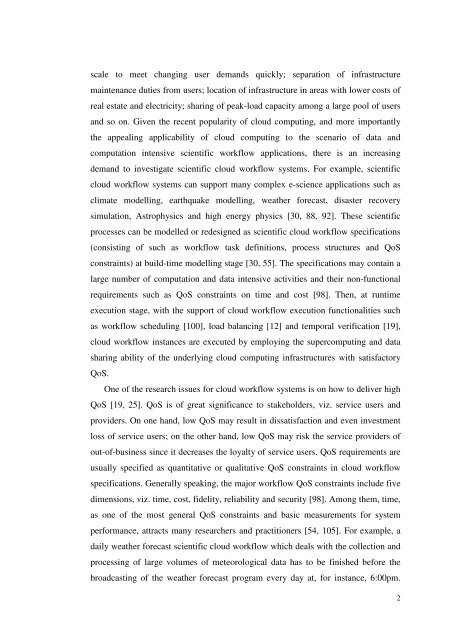Xiao Liu PhD Thesis.pdf - Faculty of Information and Communication ...
Xiao Liu PhD Thesis.pdf - Faculty of Information and Communication ...
Xiao Liu PhD Thesis.pdf - Faculty of Information and Communication ...
Create successful ePaper yourself
Turn your PDF publications into a flip-book with our unique Google optimized e-Paper software.
scale to meet changing user dem<strong>and</strong>s quickly; separation <strong>of</strong> infrastructure<br />
maintenance duties from users; location <strong>of</strong> infrastructure in areas with lower costs <strong>of</strong><br />
real estate <strong>and</strong> electricity; sharing <strong>of</strong> peak-load capacity among a large pool <strong>of</strong> users<br />
<strong>and</strong> so on. Given the recent popularity <strong>of</strong> cloud computing, <strong>and</strong> more importantly<br />
the appealing applicability <strong>of</strong> cloud computing to the scenario <strong>of</strong> data <strong>and</strong><br />
computation intensive scientific workflow applications, there is an increasing<br />
dem<strong>and</strong> to investigate scientific cloud workflow systems. For example, scientific<br />
cloud workflow systems can support many complex e-science applications such as<br />
climate modelling, earthquake modelling, weather forecast, disaster recovery<br />
simulation, Astrophysics <strong>and</strong> high energy physics [30, 88, 92]. These scientific<br />
processes can be modelled or redesigned as scientific cloud workflow specifications<br />
(consisting <strong>of</strong> such as workflow task definitions, process structures <strong>and</strong> QoS<br />
constraints) at build-time modelling stage [30, 55]. The specifications may contain a<br />
large number <strong>of</strong> computation <strong>and</strong> data intensive activities <strong>and</strong> their non-functional<br />
requirements such as QoS constraints on time <strong>and</strong> cost [98]. Then, at runtime<br />
execution stage, with the support <strong>of</strong> cloud workflow execution functionalities such<br />
as workflow scheduling [100], load balancing [12] <strong>and</strong> temporal verification [19],<br />
cloud workflow instances are executed by employing the supercomputing <strong>and</strong> data<br />
sharing ability <strong>of</strong> the underlying cloud computing infrastructures with satisfactory<br />
QoS.<br />
One <strong>of</strong> the research issues for cloud workflow systems is on how to deliver high<br />
QoS [19, 25]. QoS is <strong>of</strong> great significance to stakeholders, viz. service users <strong>and</strong><br />
providers. On one h<strong>and</strong>, low QoS may result in dissatisfaction <strong>and</strong> even investment<br />
loss <strong>of</strong> service users; on the other h<strong>and</strong>, low QoS may risk the service providers <strong>of</strong><br />
out-<strong>of</strong>-business since it decreases the loyalty <strong>of</strong> service users. QoS requirements are<br />
usually specified as quantitative or qualitative QoS constraints in cloud workflow<br />
specifications. Generally speaking, the major workflow QoS constraints include five<br />
dimensions, viz. time, cost, fidelity, reliability <strong>and</strong> security [98]. Among them, time,<br />
as one <strong>of</strong> the most general QoS constraints <strong>and</strong> basic measurements for system<br />
performance, attracts many researchers <strong>and</strong> practitioners [54, 105]. For example, a<br />
daily weather forecast scientific cloud workflow which deals with the collection <strong>and</strong><br />
processing <strong>of</strong> large volumes <strong>of</strong> meteorological data has to be finished before the<br />
broadcasting <strong>of</strong> the weather forecast program every day at, for instance, 6:00pm.<br />
2
















